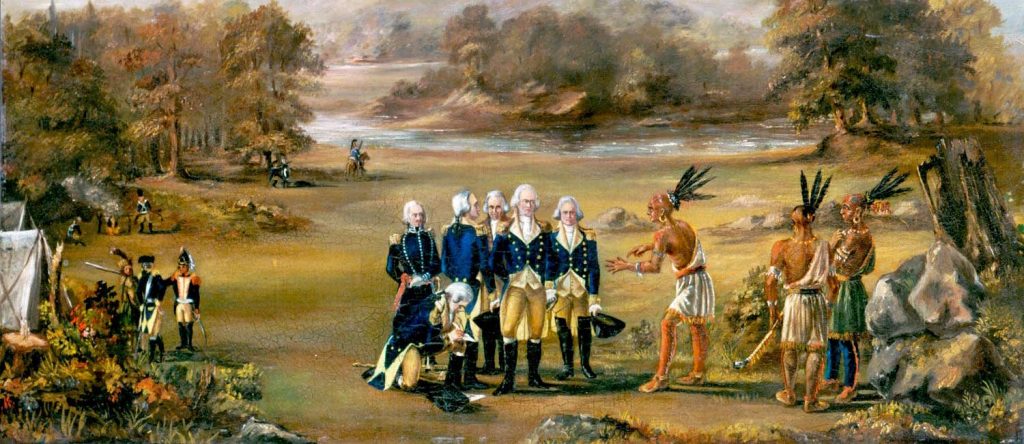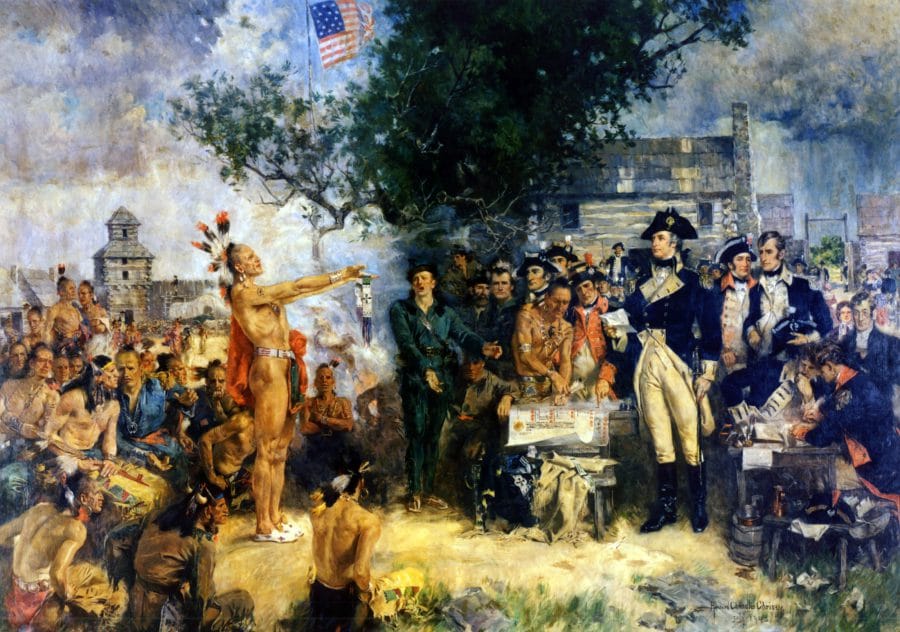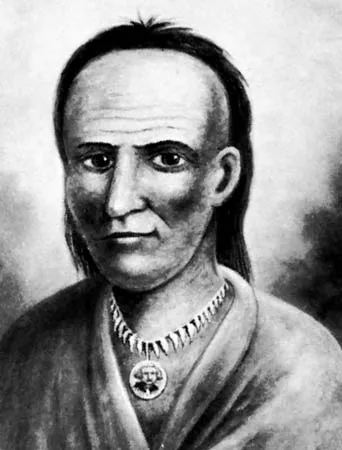Northwest Indian War (1785-1795): Conflict between the United States and Native American tribes over control of the Northwest Territory.
The Northwest Indian War (1785-1795) was a prolonged conflict between the United States and a confederacy of Native American tribes over control of the Northwest Territory, which encompassed the modern-day states of Ohio, Indiana, Illinois, Michigan, and Wisconsin. Here is the story of this pivotal war:
Origins and Causes
After the American Revolutionary War, the Treaty of Paris in 1783 ceded the Northwest Territory to the United States, despite it being home to numerous Native American tribes. The Native nations, including the Shawnee, Miami, Delaware, and others, rejected American claims to the land and formed the Western Confederacy to resist encroachment by American settlers.The British, who had not yet vacated their forts in the region, continued their policies of supporting the Native tribes against American expansion. This emboldened the Western Confederacy to declare the Ohio River as the boundary between their lands and American settlements.
Early American Defeats
In 1790, President George Washington ordered the U.S. Army, consisting mostly of untrained militia, to assert American sovereignty over the Northwest Territory. This led to devastating defeats for the Americans:
- The Harmar Campaign in 1790 resulted in the loss of nearly 200 soldiers in a series of battles near modern-day Fort Wayne, Indiana.
- St. Clair’s Defeat in 1791 was one of the worst losses ever suffered by the U.S. Army, with over 600 soldiers killed by forces led by Miami chief Little Turtle and Shawnee chief Blue Jacket.
The Tide Turns
After St. Clair’s catastrophic loss, President Washington appointed Revolutionary War hero Anthony Wayne to lead a newly trained and disciplined force known as the Legion of the United States.In 1794, Wayne’s forces decisively defeated the Western Confederacy at the Battle of Fallen Timbers near modern-day Toledo, Ohio. This victory, combined with the British withdrawal from the region following the Jay Treaty, forced the Native tribes to cede most of Ohio at the Treaty of Greenville in 1795.
Consequences
The Northwest Indian War effectively opened the Northwest Territory for American settlement and expansion, displacing Native American tribes from their ancestral lands. It marked the beginning of the United States’ policy of Indian removal and the loss of Native sovereignty over vast territories east of the Mississippi River.While a victory for the young United States, the war was marked by brutal violence on both sides, with atrocities committed against Native civilians and American settlers alike. The conflict set the stage for future Indian Wars as the nation continued its westward expansion in the 19th century.
Who was Little Turtle and what was his role in the Northwest Indian War



Little Turtle (c.1752-1812) was a renowned war chief of the Miami tribe who played a pivotal role as a military leader in the Northwest Indian War against the United States.
His role in the conflict was as follows:
- He emerged as one of the principal leaders of the Western Confederacy, an alliance of Native American tribes including the Miami, Shawnee, Delaware and others, formed to resist American expansion into the Northwest Territory after the Revolutionary War.
- In 1790, Little Turtle led Miami and Shawnee forces that decisively defeated the American militia forces of General Josiah Harmar in two battles near modern-day Fort Wayne, Indiana. This early victory emboldened the Western Confederacy.
- In 1791, Little Turtle is credited with leading the confederate forces that inflicted the worst defeat ever suffered by the U.S. Army against Native Americans at the Battle of the Wabash (also known as St. Clair’s Defeat). Over 600 American soldiers were killed.
- His strategic leadership and the confederacy’s success in these early engagements forced the U.S. to take the conflict more seriously, leading to the deployment of the Legion of the United States under General Anthony Wayne in 1793.
- In 1794, Little Turtle’s forces were defeated by Wayne’s troops at the Battle of Fallen Timbers near modern-day Toledo, Ohio, which proved to be the decisive battle of the war.
- After this loss, Little Turtle advocated for peace and was an influential voice in persuading the Western Confederacy to sign the Treaty of Greenville in 1795, ceding much of present-day Ohio to the United States.
As one of the most prominent Native American military leaders of his time, Little Turtle’s strategic acumen and battlefield successes made him a formidable adversary of the young United States in the Northwest Indian War before his eventual acceptance of peace and ceding of lands.
What were the key battles led by Little Turtle during the Northwest Indian War
Little Turtle, a renowned war chief of the Miami tribe, led Native American forces in several key battles during the Northwest Indian War against the United States. The major battles he commanded were:
- Harmar’s Defeat (October 1790)
Little Turtle and Miami warriors decisively defeated the American militia forces of General Josiah Harmar in two battles near modern-day Fort Wayne, Indiana. This early victory emboldened the Western Confederacy of Native tribes. - St. Clair’s Defeat/Battle of the Wabash (November 1791)
Considered one of the worst defeats ever suffered by the U.S. Army against Native Americans, Little Turtle led the Western Confederacy forces that decimated the American troops of General Arthur St. Clair near the Wabash River. Over 600 American soldiers were killed, nearly their entire force. - Attack on Fort Recovery (June-July 1794)
After the Americans built Fort Recovery on the site of St. Clair’s defeat, Little Turtle led around 2,500 Native warriors in an unsuccessful siege attempting to expel the U.S. troops from the fort. Though they failed to capture it, the siege showed the Confederacy’s determination.
While Little Turtle advocated peace after these victories, he played a central role in dealing the young United States some of its most humiliating defeats in the early years of the Northwest Indian War. His strategic leadership made him one of the most formidable Native American adversaries faced by the Americans on the frontier.
However, Little Turtle did not lead the forces at the decisive Battle of Fallen Timbers in 1794, where the Confederacy was finally defeated by General Anthony Wayne’s Legion. That battle was commanded by Blue Jacket of the Shawnees after Little Turtle stepped back from a frontline role.
What were the strategic advantages Little Turtle used in his battles
According to the sources provided, Little Turtle employed several key strategic advantages in the battles he led against American forces during the Northwest Indian War:
- Home Field Advantage and Mobility
As the sources note, the Native American forces led by Little Turtle had the advantage of fighting on their home terrain in the forests of the Northwest Territory. They were highly mobile and could choose when and where to engage the American troops. This allowed them to strike at opportune moments and then quickly disengage or retreat. - Surprise and Ambush Tactics
Little Turtle made effective use of surprise and ambush tactics against the American armies. At St. Clair’s Defeat in 1791, his forces lay in wait in the woods and launched a coordinated dawn assault that encircled and decimated St. Clair’s troops before they could properly react. The element of surprise was a major factor in this overwhelming victory. - Exploiting Enemy Vulnerabilities
Little Turtle identified and exploited the weaknesses of the poorly trained and supplied American militias. At St. Clair’s Defeat, he instructed his warriors to concentrate fire on the officers and artillery crews first. He also took advantage of the Americans’ failure to properly secure their camps or scout the area adequately. - Defensive Terrain
When possible, Little Turtle positioned his forces on terrain conducive to defense, like the Wabash mound that provided an elevated position overlooking marshy areas at St. Clair’s Defeat. This negated some of the American advantages in firepower. - Intelligence Gathering
Little Turtle’s forces were well-provisioned and fully informed about the movements and dispositions of the American armies. This intelligence allowed them to plan ambushes and choose advantageous engagement points. - Allied Support
Though not decisive, Little Turtle’s forces received some support from British forts and arms in the region, emboldening their resistance to American expansion into Indian lands.
By leveraging mobility, surprise, knowledge of terrain, and the weaknesses of his adversaries, the Miami chief Little Turtle was able to inflict devastating losses on the American armies through brilliant tactical leadership before his eventual defeat at Fallen Timbers.
How did Little Turtle’s tactics impact future U.S. military strategies
Little Turtle’s successful tactics against the U.S. forces in the early battles of the Northwest Indian War had a significant impact on shaping future American military strategies and reforms. The devastating defeats he inflicted exposed critical weaknesses that the young nation had to address. Here are some key ways Little Turtle’s tactics influenced subsequent U.S. approaches:
- Need for Professional Standing Army
The routs of the poorly trained militia forces under Harmar and St. Clair demonstrated the necessity of having a professional, well-disciplined standing army. This led to the formation of the first permanent U.S. Army units like General “Mad” Anthony Wayne’s Legion of the United States that received proper training. - Emphasis on Frontier Tactics and Mobility
Little Turtle’s mastery of ambush, hit-and-run tactics, and exploiting terrain advantages showed U.S. commanders the importance of training troops in frontier-style warfare suited to the wilderness. This contrasted with European linear tactics and promoted greater mobility and light infantry. - Improved Scouting and Camp Security
The devastating surprise Little Turtle achieved at St. Clair’s Defeat by discovering the American camp’s lack of perimeter defenses and sentries underscored the need for better scouting, reconnaissance, and fortified camps when operating in hostile territory. - Countering Native Tactical Advantages
To neutralize Native American advantages in stealth, woodland combat, and ambush tactics that Little Turtle employed so effectively, the U.S. adopted more aggressive patrol and skirmishing methods to deny enemies the chance to choose the time and place of attack. - Recognizing Importance of Artillery
The lack of artillery support left U.S. forces badly outgunned against Little Turtle’s warriors. This highlighted the need to ensure adequate artillery accompanied expeditions against Native forces.
While ultimately defeated by Wayne’s reformed forces at Fallen Timbers in 1794, Little Turtle’s string of early victories forced the young United States to critically examine its military’s deficiencies and implement wide-ranging reforms in training, tactics, and doctrine more suited to frontier warfare. His brilliant leadership directly impacted the professionalization of the U.S. Army.